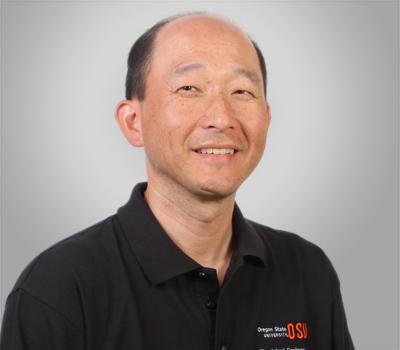The Center for Design of Analog-Digital Integrated Circuits, a graduated NSF industry/university cooperative research center established in1989, has been a global powerhouse of innovation in the field of analog, RF, and mixed-signal integrated circuits. By engaging with CDADIC, industry partners have early access to pioneering research and to a promising new generation of engineers, enabling them to leverage the university’s investments to multiply their own. Multiple underpinnings make CDADIC a crucial player in analog-digital circuitry.
Center focus: Advancing analog/mixed-signal and RF IC design
CDADIC aims to address industry challenges, develop practical solutions, and foster the development of highly skilled professionals to meet the evolving demands of the industry.
An essential aspect of CDADIC is its world-class faculty, concentrated at Oregon State University, the University of Washington, and Washington State University. The multiuniversity assembly of researchers enhances the quality and diversity of research and teaching, creating an environment rich in ideas, perspectives, and expertise.
The industry side of this consortium is growing and currently joined by key players, including Analog Devices, Qualcomm, Rohde & Schwarz, Skyworks, SRC, Tektronix, Texas Instruments, and Tower Semiconductor.
CDADIC’s focus has significant implications for industries such as:
- Automotive/transportation.
- Communications.
- Environmental sensing.
- Medical electronics.
- Security and safety systems.
- Smart cities.
- Space tech.
These areas are clamoring for high-speed, high-resolution, low-power performance analog, RF and mixed-signal circuits, and CDADIC is at the forefront of meeting this demand.
Industry-university partnership: Driving innovation and impact
At the heart of CDADIC's success lies its strong industry-university partnership. By collaborating with industry leaders, CDADIC ensures that its research remains relevant and aligned with the needs of the industry. This partnership benefits both industry partners and academic researchers. Industry partners gain access to cutting-edge research, emerging technologies, and a diverse talent pool, while academic researchers benefit from industry insights, resources, and the opportunity to work on practical applications.
The partnership is nurtured through biannual meetings, which serve as a platform for industry members and researchers to connect, exchange ideas, and provide direct feedback on ongoing projects. These gatherings foster a collaborative atmosphere, enabling fruitful brainstorming sessions and leading to innovative ideas and breakthroughs.
Ongoing projects 2023-24: Pushing boundaries in IC design
CDADIC's ongoing projects for 2023-24 encompass a range of analog/mixed-signal and RF IC design areas. Here are some notable projects and the respective professors leading them.
Analog/mixed-signal projects
- High-Performance Mixed-Signal Circuits in CMOS, led by Un-Ku Moon
- Micro-Power CMOS Interface Circuits, led by Gabor Temes
- Data Encoding Techniques for Wireline Links: Balanced Coding, led by Tejasvi Anand
- Low-Power Integrated Circuit and Integration Approaches for Intelligent Sensor Systems, led by Matthew Johnston
RF-front end and wireless techniques projects
- Interferer-tolerant, Wireless Transceivers for Radar and Internet-of-Things, led by Arun Natarajan
- Phase Noise Suppression for Multi-band Quadrature Receiver Applications, led by Jacques (Chris) Rudell
- Wideband Current-Mode True-time-delay based Conformal Antenna Arrays, led by Subhanshu Gupta
- PVT Invariant Low-Power Low-Jitter High-Frequency Clock Generation for 5G and Beyond, led by Deukhyoun Heo
- Modeling and Design of Passives for RF and Millimeter-Wave Integrated Circuits, led by Andreas Weisshaar
These projects represent the forefront of analog/mixed-signal and RF IC design research, addressing critical challenges and pushing the boundaries of what is possible. Each project brings together a team of talented researchers, graduate students, and industry experts to collaborate on cutting-edge solutions that have real industry application.
Technology breakthroughs and notable outcomes: Driving technological advancements
The collaborative efforts of CDADIC have yielded remarkable outcomes, driving significant advancements in the field of IC design. With over $25 million in direct research support, CDADIC has successfully executed more than 300 sponsored research projects, forging strong ties with industry partners and government agencies alike.
These collaborative endeavors have resulted in groundbreaking research findings, showcased through over 1,000 publications and 1,500 presentations by CDADIC's researchers. The center's commitment to bridging the gap between theory and practical application has ensured that its research outcomes have a real-world impact. This is further evident through the patents and technology transfer agreements that CDADIC has achieved, demonstrating the commercial viability and industry relevance of its innovations.
In addition to its research accomplishments, CDADIC has played a pivotal role in graduate education, graduating hundreds of M.S. and Ph.D. students who have gone on to become leaders in the field. By nurturing and training the next generation of researchers and engineers, CDADIC has made a lasting contribution to the IC design community, ensuring a continued cycle of innovation and progress.
Craig Scott, NSF I/UCRC evaluator, has historically been tasked with putting together a compendium that lists industry-nominated technology breakthroughs from all of the current and graduated centers.
Networking with CDADIC: Collaboration and workforce development
CDADIC membership provides access to a pool of talent, influence in training future prospective employees, information about research activities, and a broad network of students and faculty. It also allows engagement through student internships, sponsored research, faculty consulting opportunities, and capstone projects.
By fostering strong partnerships with industry leaders, CDADIC remains at the forefront of technological advancements, addressing industry challenges, and driving innovation. The ongoing projects and research efforts are pushing the boundaries of IC design, resulting in notable outcomes and technology breakthroughs that have the potential to shape the future of the industry. CDADIC continues to play a pivotal role in developing highly skilled professionals and nurturing the next generation of IC designers. The center's commitment to bridging the gap between academia and industry ensures that research outcomes are practical, impactful, and aligned with the evolving needs of the industry.
To explore collaborative opportunities, or the semiconductor program in general, get in touch with us at: semi-osu@oregonstate.edu.







